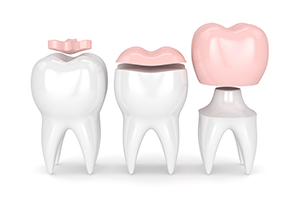 Most people know what’s necessary after a tooth gets a cavity. It needs a filling, of course! Fillings are very common and a minor variety of restoration. On the other end of the spectrum, when extensive tooth damage or decay has occurred (and yet the tooth is still viable), we might use a dental crown (or “cap”) to reinforce the tooth. Crowns fit over the entire visible portion of the tooth, effectively replacing everything above the gum line. Crowns are also a routine procedure and nothing to worry over. Finally, for those moderate cases of tooth damage, we might recommend what’s called inlays and onlays.
Most people know what’s necessary after a tooth gets a cavity. It needs a filling, of course! Fillings are very common and a minor variety of restoration. On the other end of the spectrum, when extensive tooth damage or decay has occurred (and yet the tooth is still viable), we might use a dental crown (or “cap”) to reinforce the tooth. Crowns fit over the entire visible portion of the tooth, effectively replacing everything above the gum line. Crowns are also a routine procedure and nothing to worry over. Finally, for those moderate cases of tooth damage, we might recommend what’s called inlays and onlays.
When are inlays and onlays used? What are the benefits?
Inlays and onlays help preserve more of your natural teeth than a crown, yet they treat more severe damage than a simple cavity filling. Sometimes, we’ll recommend them after a cavity treatment has failed and the filling has fallen out, or simply because additional damage and decay has occurred.
What’s the difference between the two?
An inlay versus onlay is all about the positioning of the restoration. An inlay lies within the cusps (or ridges) of your tooth’s chewing surface, where many cavities tend to begin. Onlays, on the other hand, replace damage to the cusps themselves, so they are typically a little larger or off-centered on the tooth. So, although called different names, they both seek to achieve the same purpose—retaining more natural tooth structure while reinforcing the strength and functionality of your tooth.
What’s involved?
To achieve an effective inlay or onlay, we first take an impression (mold) of the treatment area. We then fit the restoration to your exact specifications according to the impression. The inlay or onlay itself is made from aesthetic tooth-colored porcelain, matching the shade of your natural teeth. Once completed and bonded into place, it will be virtually indistinguishable from your natural tooth enamel!
